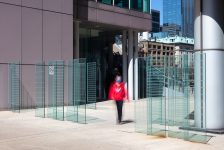Positioned between Toronto’s Metro Hall and the Marathon office building on Wellington Street are 36 screens made of tempered-glass, designed by Jaan Poldaas. While the screens are aesthetically pleasing they are also practical, serving as a comforting windbreak, for what has turned in to a wind tunnel between two buildings, and also a gateway to and from the main areas of the David Pecaut Square.
Poldaas’ sculpture is divided into smaller sections of panels, in groups of threes and fives, staggered carefully so that people may easily pass through. Etched with vertical and horizontal lines, Poldaas intended for his mathematically spaced glass panels to symbolize the way in which our civic government functions.


